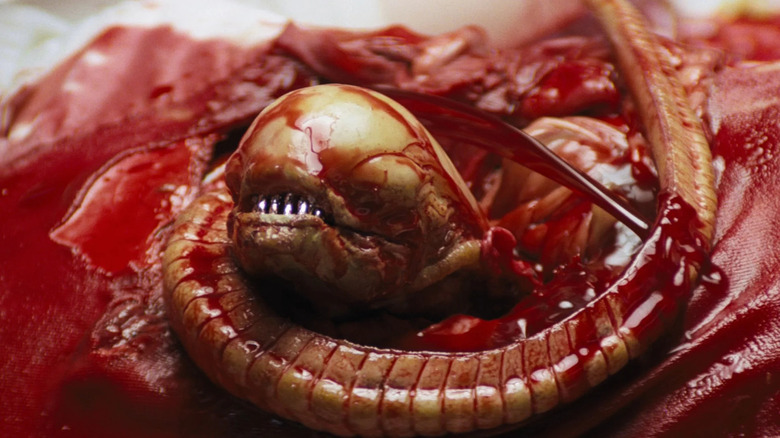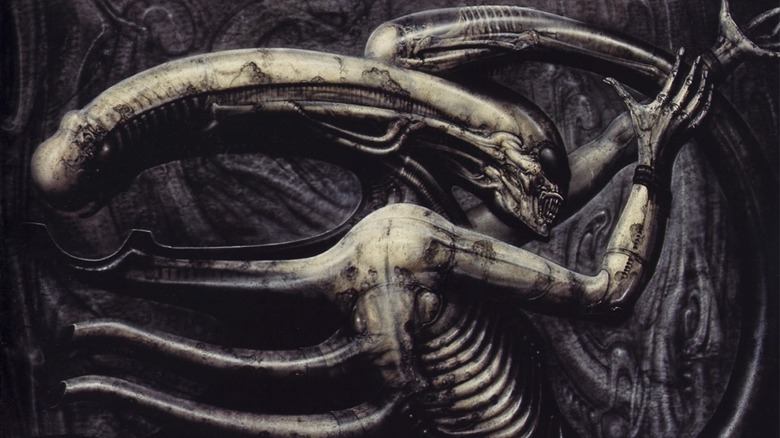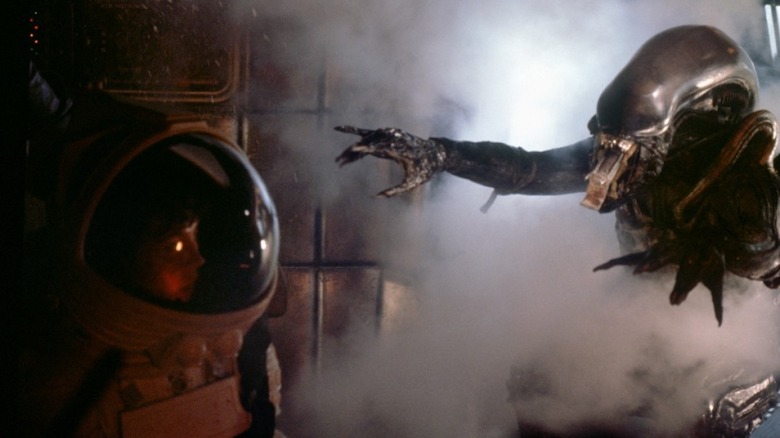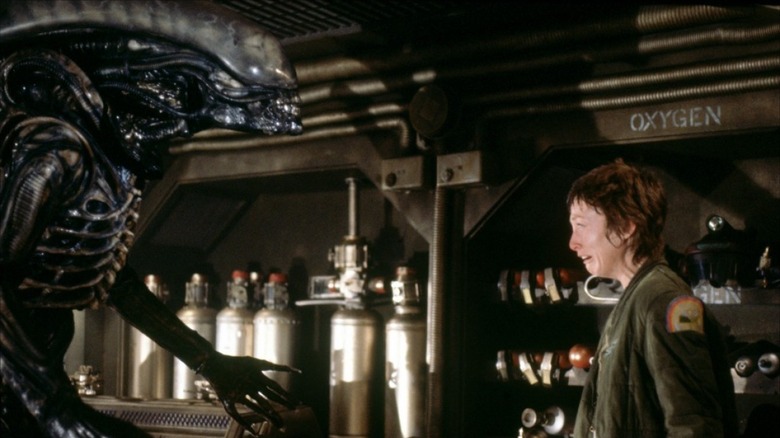
The backstory of Ridley Scott's 1979 sci-fi film "Alien" is well-known to its fans, and many details are in the 2019 documentary "Memory: The Origins of Alien." Screenwriters Dan O'Bannon and Ron Shusett intended "Alien" to be a low-budget B-picture, thrown off in a few weeks with fingers crossed that it make its modest budget back. The original title was "Star Beast" (changed to "Alien" because they liked its double-duty as a noun and adjective), inspired by the legend of gremlins that would foul up the mechanical elements of World War II bombers.
O'Bannon and Shusett were on the cusp of signing a deal with legendary B-movie luminary Roger Corman, who would have made "Alien" on the cheap, when they were offered a better deal. O'Bannon admits he modeled the script on his favorite monster movies of a previous era: "The Thing from Another World," Mario Bava's "Planet of the Vampires," and of course, "Forbidden Planet." It was never meant to be as weird, striking, or brazenly terrifying as it ended up being.
The final script for "Alien," extensively rewritten by Walter Hill and David Giler, was something far slower, scarier, less "drive-in B-picture" than "A-budget horror."
Swiss surrealist H.R. Giger, whom O'Bannon had first encountered while working on the famously defunct "Dune" feature film to have been made by Alejandro Jodorowsky, was recommended to Scott as a potential designer of the title creature. Giger had established himself as an artist in Switzerland in the late 1960s, and his work had appeared on album covers by Emerson, Lake & Palmer and Magma. His brand of what he called biomechanics was already causing a stir in the art scene. His painting "Necronom IV" served as the primary inspiration for the Alien, featuring a humanoid figure with an elongated phallic head, visible ribs, tubelike tendrils extending from its back, and an additional outsize phallus in the traditional place.
In a 2017 interview with Emmanuel Levy, Scott recalled working with Giger, how much fun they had, and how many felt his art was perhaps a little too extreme.
Obscene And Dark

Ridley Scott recalls perusing H.R. Giger's 1976 book "Necronomicon," looking over "Necronom IV," and loving how disturbing it was. Evidently, the Fox heads noticed the same thing, but didn't respond with the same macabre fascination. Scott told Emmanuel Levy:
"I had a good time with Giger. When I was going to do 'Alien' I had seen a book called 'Necronomicon' and it had a marvelous picture in it, which in effect was the Alien. Fox weren't sure about it at the time and they said it was obscene and dark and I said, 'obscene and dark is good, we are about to do a horror movie, dude.'"
Scott recalls first working with Giger, having to convince him to come to England — by train; Giger refused to fly on planes — and work on designs. Giger didn't stay in a hotel like one might expect. Scott continued:
"So I flew to Switzerland and I met with him cause he wouldn't fly. And he was a very sweet man, despite the dark side to his illustrations. He works out the dark side in his drawings and his paintings, cause as a person he's a sweetheart. I persuaded him to get on a train and come to England, saying 'where would you like to stay?' I expected him to say The Dorchester, but he said no, is there a pub in Shepperton's Village? He stayed for nine months in a pub in Shepperton Village with his wife, who was also his manager, Mia."
Visiting Giger, Scott recalls, was a hermetic experience, sealed off from other elements of production:
"We had a private lockup in Shepperton Studios which in effect was his studio, and I was the only one allowed. Every afternoon after I had preparing stuff and whatever I was doing as a director, pre-shooting and going out at 5 o'clock virtually going into an airlock, and inside I would see the evolution of the creature."
The Best Movie Creature Ever

Ridley Scott loved the Alien to a reasonable degree. It is truly a strange and, well, alien thing. Scott admits that most movie monsters, at least to his taste, looked a little too animal. Even dinosaurs had a gentle quality:
"[Giger] tried to improve the illustration, and frankly he couldn't, it was so beautiful and disturbing. Probably the Alien is the best — honestly — film creature ever. 'Cause dinosaurs are accurate and somehow more benign in the sense that elephants are beautiful and benign. But this Alien creature is disturbing. Apart from a shark, snakes are usually disturbing. A king cobra will kill you in 14 minutes and you have no antidote."
Giger's design for the Alien would be carried into multiple sequels, though Scott admits the limitations in VFX technology in 1979 left him stymied a bit. Ultimately, an actor had to get into the alien suit. The creatures in James Cameron's 1986 film "Aliens" were clearly actors in suits. It wouldn't be until 2017's "Alien: Covenant," the sixth film in the series (and the third made by Scott), that modern VFX tech could fully realize the creature. However obscene the creature was in 1979, Fox now allowed Scott to bring it to life in CGI. But, he was quick to point out that the mixture of CGI and practical effects was still the most effective way to realize a monster:
"The fact that I had to have a guy in a rubber suit in 1979, cause that was the only method, but having to make the mechanics and make the head and the double mouth and all of that kind of thing. I think it was really well done considering it was 1979. Nothing digital at all. Later, I have got digital capability where you can do anything, but there's something about digital that you have to be very careful about that it doesn't look digital."
Bringing It All Together

Of course, a challenge of digital effects is making sure the actors — and the audience — can still perceive a degree of verisimilitude in partnership with the behind-the-scenes magic. Ridley Scott continued to Emmanuel Levy:
"I can't have actors standing there looking at a blank space. On the floor the actor has something, the guy is going to be pretty damn good and today the suit was brilliantly done and the head was brilliantly done by my favorite guy Connor, who does all my prosthetics, and he is a real artist. Connor is also designing and making what I call the baby Aliens, the baby neomorph and the baby xenomorph. So when it's coming out of Billy Crudup's chest, that was a puppet coming up, so it stands up, does that and puts his arms up. And I shoot that, and it looks pretty damned good. But there were other bits and pieces that weren't quite right, so then we re-conform it, but digitally. The digital process gives you final gloss and polish."
"Alien" began a long-running film series and inspired video games, comic books, and would even cross over with John McTiernan's 1987 film "Predator" in multiple iterations. Obscenity be damned — it seems the Alien is now a pop culture symbol.
Read this next: 20 Movies About Aliens That You Definitely Need To Watch
The post Fox Thought H.R. Giger Was Too 'Obscene' to Work On Alien appeared first on /Film.
/Film https://ift.tt/3gWElyV April 28, 2022 at 01:14PM
Комментарии
Отправить комментарий